The answer to any physical problem must eventually return to the universe itself. However, if the answer no longer exists, what should we do? Of all the questions about the universe that human beings can think of, perhaps the biggest question is: where did the universe first come from? This is not a simple problem, because to understand where something comes from, we must first know exactly what it is. Similarly, we must fully understand the laws of physics in order to calculate the results of a physical system from a specific set of initial conditions Only from these initial conditions can we determine the possible way things evolve, understand how they become what they are today, and find out which predictions are consistent with our universe
However, the incredible thing about this way of thinking is that no matter whether we raise this problem in the past or in the future and solve it with scientific methods, we will always get the same cosmic story. Today, human beings have traced the origin of the universe to an incredible extent, and have even determined the origin of planets, stars, elements, atoms and other things. We have found a lot of evidence about the cosmic thermal big bang, and even the information before the big bang. Despite these understandings, there are still many grand and unknown mysteries related to the universe waiting for us to solve. This is where we are today.
Today, when we look at the universe outside the earth, a brilliant and quite comprehensive picture will emerge. The planet we inhabit, like other planets in the universe, is composed of atoms. The center of a solid consisting of the densest and heaviest atoms is covered by a gaseous atmosphere. The lighter layer floats on top of the heavier layer, forming an onion like structure, as is the case with every planet, dwarf planet and satellite that has been fully studied by humans so far.
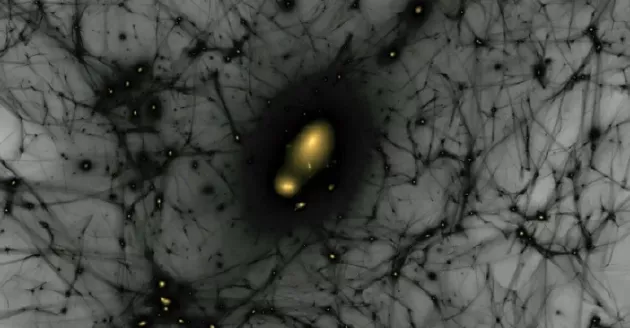
The cosmic web is the largest structure in the universe, mostly composed of dark matter. However, on a smaller scale, baryons can interact with photons to form stellar structures, but also release energy that can be absorbed by other objects. Dark matter and dark energy are not competent for such a function.
Planets can either float freely in galaxies or orbit stars. The core of the star has been undergoing nuclear fusion reaction, fusing lighter elements into heavier elements. When a star runs out of fuel, its core collapses and heats up. If the temperature is high enough and the density is high enough, the next group of elements in the reaction chain will continue to fuse; Otherwise, the star will be transformed into stellar debris. In some cases, the debris is mild, but in other cases, it will have a violent reaction.
On a larger scale, stars are grouped into larger collections, namely galaxies; Galaxies gather into clusters, that is, galaxy clusters and galaxy clusters, and even larger superclusters. Together, they form the so-called "cosmic network", galaxies are arranged along large-scale fibrous structures and clustered into superclusters at the connecting nodes of the fibers; At the same time, the structure is separated by a huge, empty space called a "hole".
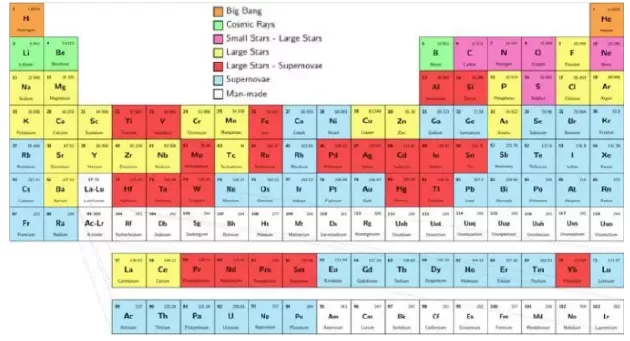
The main sources of various elements found in the universe today. Among them, small stars are any stars whose mass is not enough to become SUPERGIANTS or supernovae; Many elements thought to come from supernovae are more likely to be created by the merger of neutron stars.
This is what the universe looks like today. If we want to know how the universe became like this, we must apply the laws of physics to the universe and follow the known laws of physical system evolution. For example:
(1) We know how universal gravitation works, and there is the general theory of relativity that governs gravitation. Therefore, as long as there is mass or energy, there is the phenomenon of universal gravitation;
(2) We know how electromagnetic force works; When an object is charged, whether it is moving or stationary, or exists in the form of electromagnetic waves (such as photons), it will involve the action of electromagnetic force.
(3) We know how nuclear forces work, including how quarks and gluons combine to form protons and neutrons, how protons and neutrons combine to form nuclei, and how unstable nuclei (including other combinations of quarks and / or anti quarks other than protons and neutrons) undergo radioactive decay;
(4) We know how to calculate the time evolution of any physical system used in the beginning.
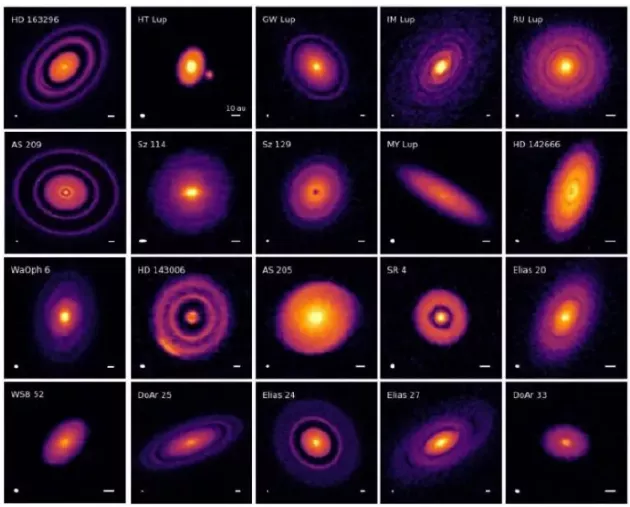
These are 20 protoplanetary disks measured by the high angular resolution disk structure project (dsharp), all around young stars. Such observations show that the protoplanetary disk is mainly formed on one plane, which is consistent with the theoretical prediction and the position of planets in the solar system.
Simply put, if you give physicists a set of initial conditions to describe your system, they can write the equations that control the evolution of the system and tell you - reaching the inherent uncertainty and non decisive limits of nature - what the result (or set of probability results) of the system at any time in the future.
So where did all this come from
Let's start with the earth. The earth is full of complexity and diversity, even intelligent life, atmosphere and ocean, as well as layered internal structures such as crust, mantle, outer core and core. In short, the earth is composed of atoms, but on a more complex level, the earth is composed of a complete set of atoms that make up the periodic table of elements, mainly iron, oxygen, silicon, magnesium, sulfur, nickel, calcium and aluminum.
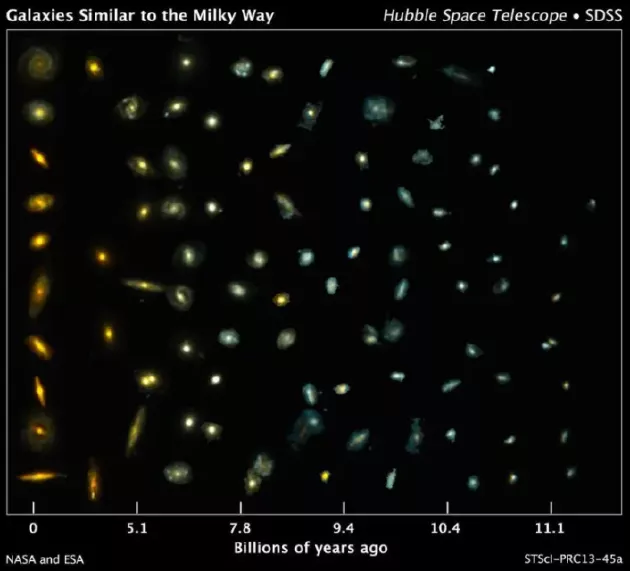
Throughout the history of the universe, there are a large number of galaxies comparable to today's Milky way. Their mass has been growing and their structure has been evolving. Compared with today's galaxies, young galaxies are smaller, bluer, more chaotic, richer in gas and less dense in heavy elements.
This is interesting because most of these elements are heavy elements, not the lightest hydrogen and helium. However, when we observe the universe, we will find hydrogen and helium everywhere. In fact, these two elements are extremely rich and constitute more than 99% of the atoms in the universe; By number, less than 1% of the atoms in the universe are heavier elements than hydrogen and helium.
Therefore, in order to make a planet like Earth - composed of rocks, metals, ice and complex molecules - we need some way to make these heavier elements, and then gather them in enough quantities to form a planet. Fortunately, when we look at the universe, we can see the processes necessary for all this to happen.
Nuclear fusion occurs inside stars, and lighter elements form heavier elements. At the end of stellar life, their fate varies according to their mass:
(1) Become red giants and new nuclear reaction processes appear, which will not happen for most of their life;
(2) Generate strong winds that blow away a large part of the star's mass;
(3) Dying in a planetary cloud, the remaining core shrinks into a white dwarf;
(4) It may die in the form of supernova with core collapse, and the remnants of implosion will either become neutron stars or black holes;
(5) These remnants, whether white dwarfs or neutron stars, will then collide, triggering runaway nuclear fusion reactions, creating richer heavy elements.
This explains why we can only find very few previously formed stars in some star clusters - which is consistent with the observations. For example, star clusters outside the Galactic halo have relatively low abundance of heavy elements. Similarly, in some star clusters, stars form more generations. For example, in the plane of galaxies close to the center of galaxies, the abundance of heavy elements is higher.
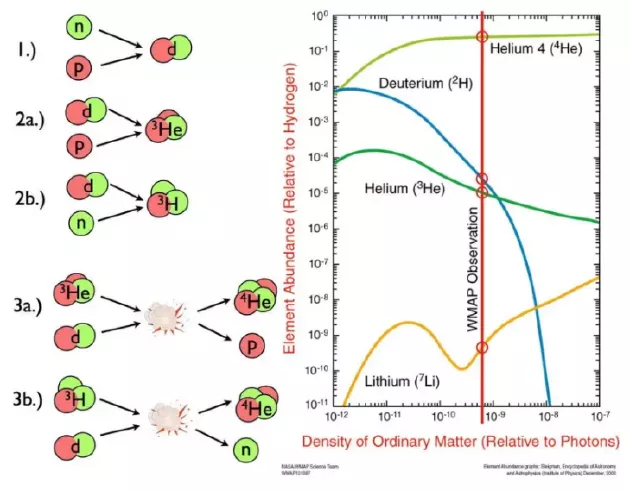
The lightest element in the universe was produced in the early days of the thermal big bang. Protons and neutrons fused together to form isotopes of hydrogen, helium, lithium and beryllium. Beryllium is unstable, and only the first three elements before star formation are left in the universe. By comparing baryon density and photon number density, we can obtain the ratio of observable elements, which enables us to quantify the degree of matter antimatter asymmetry in the universe.
In addition, astronomers recently directly photographed the disk formed around new stars: the protoplanetary disk. Inside the disk, they found large and small voids and clumps, as well as evidence of the existence of young and newborn planets. After the birth, existence and death of several generations of stars, the new generation of stars is rich in material recovered from previously dead stars, resulting in planets, including rocky planets with life components.
In fact, when we further review the long history of the universe, we will see that not only a large number of heavy elements are evolving, but also galaxies themselves are evolving. In the adjacent universe, we have found huge spiral galaxies and elliptical galaxies, which are densely clustered, have low star formation rate, large mass and relatively low gas content; Overall, the proportion of red stars in these galaxies is larger than that of blue stars. However, as we look farther and farther away, we will notice two main differences between galaxies:
(1) The farther away the galaxy is, the lower its degree of evolution. They are less massive and less concentrated, and star formation peaked about 11 billion years ago and has declined since; They are rich in gas and have low abundance of heavy elements. Compared with today's galaxies, the relative abundance of blue stars is higher than that of red stars;
(2) In addition, the farther away a galaxy is, the more its light will systematically move to a longer wavelength, which is the so-called "cosmological red shift".
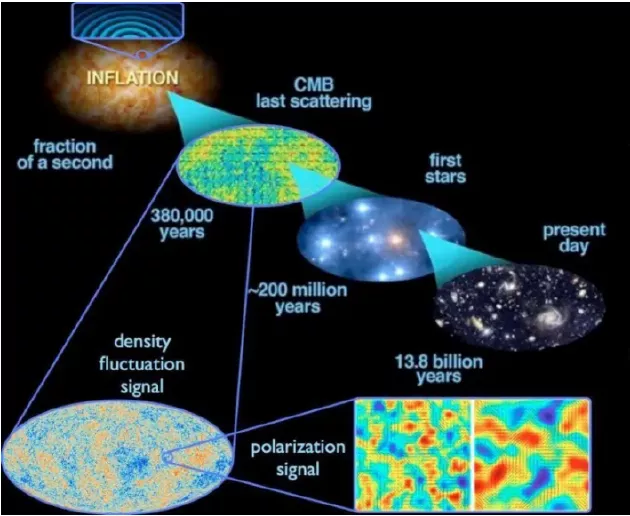
In the process of inflation, the fluctuation of space-time itself on the quantum scale is stretched in the whole universe, resulting in the defects of density and gravitational wave. Although in many ways, the inflated space can be called "nothingness", whether in the period of inflation or today, the cosmic space has a positive and non-zero energy density.
Second, in the framework of general relativity, we will draw the conclusion that the universe is expanding. Expansion causes all light to show a cosmic redshift when passing through intergalactic space, so the farther an object is, the greater its redshift and the faster it looks away from us. And - and perhaps most importantly - we will see what they were like a long time ago, because light can only travel at a limited speed. In special relativity, the speed of light is the upper limit of the speed of all matter movement and information transmission in the universe.
However, a clear fact is that galaxies will grow and evolve over time. This gives us some far-reaching enlightenment: if we can look back early enough, we may find the "earliest" star clusters and galaxies; Before that node, there were no stars or galaxies in the universe. If the universe:
(1) Has been expanding;
(2) Continuous cooling;
(3) The gravitational effect becomes "more bulky" over time.
Then we can conclude that the early universe was smaller, denser, hotter and more uniform than it is now. Using this logic, we can infer the initial situation of the universe with appropriate physical principles.
That's what astronomers do and come up with a series of unusual predictions:
(1) According to the law of the growth of gravitational effect in the expanding universe, the universe will only develop structures such as galaxies, galaxy clusters and cosmic networks;
(2) There is a time when stars and galaxies first formed. Before that, there was only primitive gas in the universe;
(3) Before this period, the radiation of the universe will be so strong and the temperature is so high that it is impossible to form neutral atoms. Therefore, there should be some signs when stable neutral atoms are formed for the first time;
(4) In earlier times, the universe would be too hot to form stable nuclei. Therefore, when the universe cools below this threshold, there should be a group of elements with specific abundance, which are formed by the fusion reaction of the early universe.
All these predictions have been confirmed by observations, but other findings are more impressive. For example, the cosmic microwave background radiation, which is only 2.725K higher than absolute zero, is consistent with the afterglow of the big bang expected by scientists. Astronomers also detected evidence of the first primitive gas clouds and found that they were composed entirely of hydrogen, helium and a small amount of lithium. We even indirectly detect the expected neutrino and anti neutrino background residues from the temperature defect imprints of neutrino and anti neutrino in the cosmic large-scale structure and cosmic microwave background.
According to the observed cosmic facts, the universe must be born on the basis of its large-scale structure "seeds", which are initially composed of a series of high-density regions and low-density regions.
So, what caused the initial high-density and low-density areas? This involves the excellence of the theory of cosmic inflation. This theory not only provides a quantum fluctuation mechanism to produce these cosmic structure "seeds", but also explains the observed cosmic characteristics (the same temperature, spatial flatness, large-scale uniformity, etc.) and can make new predictions about what these quantum fluctuations should look like.
According to the theory of cosmic inflation, during the thermal big bang, the hot, dense, basically uniform and rapidly expanding universe was full of matter and radiation, but before that, the universe was completely empty. However, the universe at this time is not without energy (or very little energy, just like today's dark energy), but contains huge energy in the space structure. As the universe expands, more space is created, keeping the energy density constant. As a result, the universe is endowed with the same properties everywhere. It is stretched to the degree of extremely flat curvature - the density of matter in the universe is very close to the critical density required by a flat universe. On the other hand, quantum fluctuations, which usually spread all over space on a small scale, have been stretched to a huge cosmic scale by inflation.
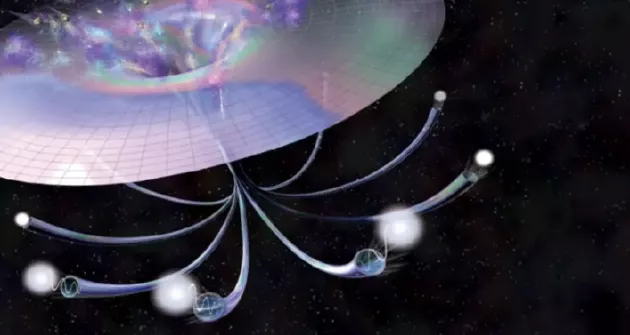
Starting from an existing state, inflation theory predicts that with the continuation of inflation, there will be a series of universes, each of which is completely separated from other universes and separated by more expanded space.
According to the prediction of inflation theory, these quantum fluctuations have created the seeds of large-scale structures in today's universe. They should have the following characteristics:
(1) It has almost the same amplitude on all scales;
(2) Produced on a larger scale than the horizon of the universe (that is, a larger range than the possible propagation of light since the beginning of the thermal Big Bang);
(3) 100% adiabatic (constant entropy), equal curvature 0 (constant spatial curvature).
Inflation theory also predicts that the nature of the residual glow of the Big Bang can indicate the maximum temperature of the thermal big bang, which is much lower than the possible maximum temperature - Planck temperature. According to the standard cosmological model, Planck temperature is the basic upper limit of temperature, and modern physical theory fails at this temperature. At present, there is no widely accepted quantum gravity theory to explain it. In other words, this is a basic limit of the combination of quantum theory and gravity. When the temperature reaches Planck temperature, the quantum gravity effect will intervene.
Unfortunately, this is the longest period of our understanding of the universe today. Because of the nature of inflation, it is bound to erase any information in the universe that existed before it happened. In fact, we can only hope to see what happened in the last stage of the inflationary period - about 10 ^ - 32 seconds after the big bang; Anything that happened before can not be detected in today's universe. Although we can confidently speculate where the observable universe comes from and explain the origin of many phenomena in the universe, similar questions, including the original origin of space, time, energy or physical laws, have not yet been answered.
To be sure, everything we know now is limited. A limited number of particles encode a limited amount of information, and they exist for a limited time in the visible universe. But why is the universe full of matter and antimatter? Why is there dark matter and dark energy? And why are there physical constants with fixed values? We cannot guarantee that today's universe will give us enough information to find the answers to all these questions. Of course, there is a long way to go. As long as we don't give up looking for it, mankind will slowly approach the truth of the universe. (Ren Tian)